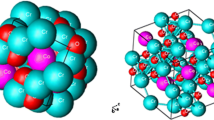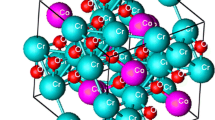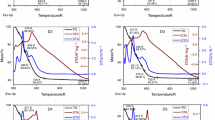Abstract
This study reports the preparation and characterization of CuCr2O4/SiO2 and Cu2Cr2O4/SiO2 nanocomposites. In order to obtain 50 mass% CuCr2O4/SiO2 and Cu2Cr2O4/SiO2 nanocomposites, we have used a method based on the thermal decomposition of the precursors Cu(II) and Cr(III) carboxylate type complexes inside the SiO2 matrix. The precursors were formed inside the gels during the redox reaction between Cu(II) and Cr(III) metal nitrates and 1,3-propanediol (1,3PD). As a result of the gels heating, the precursors decomposed at ~ 300 °C leading to the amorphous metal oxides CuO and Cr2O3+x. Cr2O3+x turned to crystalline α-Cr2O3 (crystalline) at 400 °C which subsequently interacted with CuO. Well crystallized Cu2Cr2O4 was obtained at 1000 °C as a result of the interaction between CuCr2O4 and residual CuO formed at 800 °C. In both samples the oxides were homogenously distributed within the amorphous silica matrix. The nanocomposite samples CuCr2O4/SiO2 and Cu2Cr2O4/SiO2 obtained at different annealing temperatures were characterized by thermal analysis, FT-IR spectrometry and powder x-ray diffraction. The results showed that the silica matrix plays a crucial role for the preparation of the desired chromite nanoparticles.





Similar content being viewed by others
References
Camargo PHC, Satyanarayana KG, Wypych F. Nanocomposites: synthesis, structure, properties and new application opportunities. Mat Res. 2009;12(1):1–39.
Kaddouri A, Mazzocchia C, Tempesti E, Nomen R, Sempere J. Sol–gel processing of copper–chromium catalysts for ester hydrogenation. J Therm Anal. 1998;53:533–45.
Lee YK, Park S, Kwo YS. Formation of methylpyrazine on a copper–chromite catalyst. Tecnol Ciencia Ed (IMIQ). 1989;4(1):34–41.
Hainic F, Plesch G, Dolezel P, Oveckova J. Study of copper chromite catalyst, III. Structure and catalytic activity of copper chromite catalyst in reductive alkylation reaction. React Kinet Catal Lett. 1986;32(2):393–8.
Kaddouri A, Dupont N, Gelin P, Delichere P. Methane combustion over copper chromite catalysts prepared by the sol–gel process. Catal Lett. 2011;141:1581–9.
Geng Q, Zhao X, Gao X, Yang S, Liu G. Low-temperature combustion synthesis of CuCr2O4 spinel powder for spectrally selective paints. J Sol-Gel Sci Technol. 2012;61:281–8.
Pishch IV, Radion EV, Sokolovskaya DM, Popovskaya NF. A pigment based on coprecipitated chromium(III) and copper(II) hydroxides. Glass Ceram. 1996;53:7–8.
Saadi S, Bouguelia A, Trari M. Photocatalytic hydrogen evolution over CuCrO2. Sol Energy. 2006;80:272–80.
Zhou S, Fang X, Deng Z, Li D, Dong W, Tao R, Meng G, Wang T. Room temperature ozone sensing properties of p-type CuCrO2 nanocrystals. Sensor Actuat B. 2009;14:119–23.
Ahmad T, Phul R, Alam P, Lone IH, Shahazad M, Ahmed J, Ahamad T, Alshehri SM. Dielectric, optical and enhanced photocatalytic properties of CuCrO2 nanoparticles. RSC Adv. 2017;7:27549–57.
Ketir W, Bouguelia A, Trari M. NO3 − removal with a new delafossite CuCrO2 photocatalyst. Desalination. 2009;244:144–52.
Asemi M, Ghanaatshoar M. Conductivity improvement of CuCrO2 nanoparticles by Zn doping and their application in solid-state dye-sensitized solar cells. Ceram Int. 2016;42:6664–72.
Jiang JZ, Goya GF, Rechenberg HR. Magnetic properties of nanostructured CuFe2O4. J Phys: Condens Matter. 1999;11:4063–78.
Prince E. Chrystal and magnetic structure of copper chromite. Acta Cryst. 1954;10:554–6.
Frontzek M, Ehlers G, Podlesnyak A, Cao H, Matsuda M, Zaharko O, Aliouane N, Barilo S, Shiryaev SV. Magnetic structure of CuCrO2: a single crystal neutron diffraction study. J Phys Condens Matter. 2012;24(1):016004. https://doi.org/10.1088/0953-8984/24/1/016004.
Chen HY, Yang CC. Transparent p-type Zn-doped CuCrO2 films by sol–gel processing. Surf Coat Technol. 2013;231:277–80.
Jlaiel F, Amami M, Boudjada N, Strobel P, Ben Salah A. Metal transition doping effect on the structural and physical properties of delafossite-type oxide CuCrO2. J Alloy Compd. 2011;509:7784–8.
Marquardt MA, Ashmore NA, Cann DP. Crystal chemistry and electrical properties of the delafossite structure. Thin Solid Films. 2006;496:146–56.
Jacob KT, Kale GM, Iyengar GNK. Oxygen potentials, Gibbs’ energies and phase relations in the Cu-Cr-O system. J Mater Sci. 1986;21:2753–8.
Gharagozlou M. Study on the influence of annealing temperature and ferrite content on the structural and magnetic properties of x(NiFe2O4)/(100 − x)SiO2 nanocomposites. J Alloys Compd. 2010;495:217–23.
Stefanescu O, Vlase G, Barbu M, Barvinschi P, Stefanescu M. Preparation of CuFe2O4 nanocomposite strating from Cu(II)-Fe(III) carboxylates embedded in hybrid silica gels. J Therm Anal Calorim. 2013;113:1245–53.
Barbu M, Stefanescu M, Stoia M, Vlase G, Barvinschi P. New sunthesis method for M(II) cromites/silica nanocomposites by thermal decomposition of some precursors formed inside the silica gels. J Therm Anal Calorim. 2012;108:1059–66.
Stefanescu O, Stefanescu M. New Fe(III) malonate type complex combination for development of magnetic nanosized γ-Fe2O3. J Organomet Chem. 2013;740:50–5.
Brinker CJ, Scherer GW. Sol–gel science—the physics and chemistry of sol–gel processing. San Diego: Academic Press; 1990.
Pathak A, Pramanik P. Nano-particles of oxides through chemical methods. PINSA. 2001;67(1):47–70.
Stefanescu M. Consideration on the formation of the mixed oxides starting from substances with high reactivity. University of Timisoara, Romania: PhD Thesis; 1993.
Stefanescu M, Barbu M, Vlase T, Barvinschi P, Barbu-Tudoran L, Stoia M. Novel low temperature synthesis method for nanocrystalline zinc and magnesium chromites. Thermochim Acta. 2011;526:130–6.
Levy LW, Goreaud M. Thermolyse einiger Kupfer (II)-Chromate, Anwendung auf die Analyse einiger Katalysatoren. Bull Soc Chim Fr. 1973;830. https://doi.org/10.1002/chin.197324051.
Ursu D, Miclau M. Thermal stability of nanocrystalline 3R-CuCrO2. J Nanopart Res. 2014;16:2160. https://doi.org/10.1007/s11051-013-2160-x.
Lenza RFS, Vasconcelos WL. Preparation of silica by sol–gel method using formamide. Mater Res. 2001;4:189–94.
Nakamoto K. Infrared spectra of inorganic and coordination compounds. New York: Wiley; 1970.
Stefanescu M, Stoia M, Stefanescu O. Nanocomposites with controlled properties obtained by the thermal treatment of some thetraethil-ortosilicate-diols-metal nitrates gels. In: Morris RE, editor. The sol–gel process. New York: Nova Science Publishers; 2011.
Berei E, Muntean C, Stefanescu O, Niculescu M, Stefanescu M. Preparation of CuCr2O4 nanopowders using two different chromium sources. J Therm Anal Calorim. 2018;131(1):137–44.
Author information
Authors and Affiliations
Corresponding author
Additional information
Publisher's Note
Springer Nature remains neutral with regard to jurisdictional claims in published maps and institutional affiliations.
Rights and permissions
About this article
Cite this article
Ştefănescu, M., Muntean, C., Berei, E. et al. Preparation and characterization of CuCr2O4/SiO2 and Cu2Cr2O4/SiO2 nanocomposites obtained from carboxylate complex combinations. J Therm Anal Calorim 138, 1887–1894 (2019). https://doi.org/10.1007/s10973-019-08479-z
Received:
Accepted:
Published:
Issue Date:
DOI: https://doi.org/10.1007/s10973-019-08479-z




